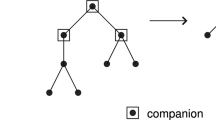Abstract
Knowledge of energy barriers between pairs of secondary structures for a given DNA or RNA molecule is useful, both in understanding RNA function in biological settings and in design of programmed molecular systems. Current heuristics are not guaranteed to find the exact energy barrier, raising the question whether the energy barrier can be calculated efficiently. In this paper, we study the computational complexity of a simple formulation of the energy barrier problem, in which each base pair contributes an energy of −1 and only base pairs in the initial and final structures may be used on a folding pathway from initial to final structure. We show that this problem is NP-complete.





Similar content being viewed by others
References
Chen SJ, Dill KA (2000) RNA folding energy landscapes. Proc Nat Acad Sci 97(2):646–651
Flamm C, Fontana W, Hofacker IL, Schuster P (2000) RNA folding at elementary step resolution. RNA 6:325–338
Flamm C, Hofacker IL, Stadler PF, Wolfinger MT (2002) Barrier trees of degenerate landscapes. Zeitschrift für Physikalische Chemie 216:155–174
Garey MR, Johnson DS (1979) Computers and Intractability: a guide to the theory of NP-completeness. W. H. Freeman & Co., New York, NY, USA
Graham R, Knuth D, Patashnik O (1989) Concrete mathematics: a foundation for computer science. Addison-Wesley, Reading, MA, USA
Kameda A, Yamamoto M, Uejima H, Hagiya M, Sakamoto K, Ohuchi A (2005) Hairpin-based state machine and conformational addressing: design and experiment. Nat Comput 4:103–126
Hagiya M, Yaegashi S, Takahashi K (2006) Computing with hairpins and secondary structures of DNA. In: Chen J, Jonoska N, Rozenberg G (eds) Nanotechnology: science and computation, natural computing series. Springer, Heidelberg, pp 293–308
Maňuch J, Thachuk C, Stacho L, Condon A (2009) NP-completeness of the direct energy barrier problem without pseudoknots. In: Proceedings of DNA 15, Fayetteville, Arkansas, USA, Lecture Notes in Computer Science, vol 5877:106–115
Morgan SR, Higgs PG (1998) Barrier heights between ground states in a model of RNA secondary structure. J Phys A Math Gen 31:3153–3170
Russell R, Zhuang X, Babcock H, Millett I, Doniach S, Chu S, Herschlag D (2002) Exploring the folding landscape of a structured RNA. Proc Nat Acad Sci 99:155–160
Seelig G, Soloveichik D, Zhang DY, Winfree E (2006) Enzyme-free nucleic acid logic circuits. Science 314:1585–1588
Shcherbakova I, Mitra S, Laederach A, Brenowitz M (2008) Energy barriers, pathways, and dynamics during folding of large, multidomain RNAs. Curr Opin Chem Biol 12(6):655–666
Simmel FC, Dittmer WU (2005) DNA nanodevices. Small 1:284–299
Tang X, Thomas S, Tapia L, Giedroc DP, Amato NM (2008) Simulating RNA folding kinetics on approximated energy landscapes. J Mol Biol 381:1055–1067
Thachuk C, Maňuch J, Rafiey A, Mathieson LA, Stacho L, Condon A (2010) An algorithm for the energy barrier problem without pseudoknots and temporary arcs. In: Proceedings of Pacific symposium on biocomputing (PSB), Honolulu, Hawaii, USA, pp 108–119
Treiber DK, Williamson JR (2001) Beyond kinetic traps in RNA folding. Curr Opin Struct Biol 11:309–314
Uejima H, Hagiya M (2004a) Analyzing secondary structure transition paths of DNA/RNA molecules. In: DNA computing. Lecture notes in computer science, vol 2943. Springer, Heidelberg, pp 86–90
Uejima H, Hagiya M (2004b) Secondary structure design of multi-state DNA machines based on sequential structure transitions. In: Proceedings of DNA9, Madison, WI, USA, Lecture notes in computer science, vol 2943. Springer, Berlin, pp 74–85
van Batenburg FHD, Gultyaev AP, Pleij CWA, Ng J, Oliehoek J (2000) Pseudobase: a database with RNA pseudoknots. Nucl Acids Res 28(1):201–204
Wolfinger MT (2001) The energy landscape of RNA folding. Master’s thesis, University Vienna
Yin P, Choi H, Calvert C, Pierce N (2008) Programming biomolecular self-assembly pathways. Nature 451:318–322
Yurke B, Turberfield AJ, Mills AJJ, Simmel FC, Neumann JL (2000) A DNA-fuelled molecular machine made of DNA. Nature 406:605–608
Author information
Authors and Affiliations
Corresponding author
Rights and permissions
About this article
Cite this article
Maňuch, J., Thachuk, C., Stacho, L. et al. NP-completeness of the energy barrier problem without pseudoknots and temporary arcs. Nat Comput 10, 391–405 (2011). https://doi.org/10.1007/s11047-010-9239-4
Published:
Issue Date:
DOI: https://doi.org/10.1007/s11047-010-9239-4




